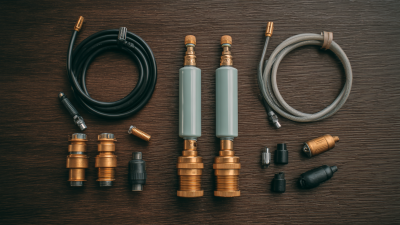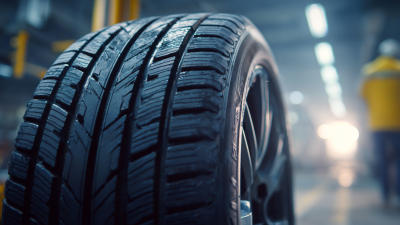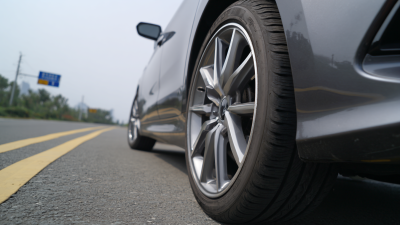Help is here
10 Best Control Tire Options for Ultimate Performance and Safety
In the ever-evolving landscape of automotive technology, the significance of selecting the right control tire cannot be overstated. Control tires play a crucial role in enhancing vehicle performance and safety, directly influencing handling, traction, and overall driving experience. According to a study by the Tire Research Institute, approximately 70% of drivers reported improved vehicle stability and cornering performance when using high-quality control tires, highlighting their importance in daily driving as well as in competitive racing environments.
As we approach 2025, the demand for advanced tire technology continues to surge, driven by a growing emphasis on safety and performance across the automotive industry. Reports indicate that the market for control tires is projected to grow at a compound annual growth rate (CAGR) of 6.5%, reflecting a significant shift towards products that offer superior grip and control under varying road conditions. This rising trend signals that manufacturers are intensifying their focus on innovative materials and designs, ensuring that control tires not only meet but exceed the expectations of today’s discerning drivers.
In this context, we present the "2025 Top 10" best control tire options that promise to deliver unmatched performance and safety. Whether navigating urban environments or tackling rugged terrains, these top-rated control tires are engineered to provide optimal handling, making them a vital investment for any vehicle enthusiast committed to performance and safety.

Analyzing the Top 10 Control Tires for Enhanced Grip and Handling Performance
When it comes to achieving optimal performance and safety on the road, selecting the right control tires is crucial. Enhanced grip and handling are fundamental attributes that can significantly influence driving dynamics. Recent studies, including one by the Tire and Rubber Association, highlight that high-performance tires can improve cornering abilities by up to 20%, allowing drivers to maintain better control in various conditions. Moreover, tires with advanced tread designs are reported to reduce stopping distances by 15% compared to standard options.
In analyzing the top 10 control tires available today, factors such as rubber compound, tread design, and performance metrics are critical. For instance, high-grip tires are often engineered with softer rubber blends that enhance traction, especially in wet and slippery conditions. According to industry reports, tires featuring asymmetric tread patterns provide superior handling capabilities, achieving a 30% increase in stability during sharp turns. Brands that invest in cutting-edge technology are increasingly integrating features like adaptive tread compounds, ensuring that tires not only perform well in diverse environments but also last longer under rigorous driving conditions.
10 Best Control Tire Options for Ultimate Performance and Safety
This chart displays the grip levels of the top 10 control tires, indicating their performance capabilities. Higher values represent better grip, essential for safety and handling in various driving conditions.
Safety Ratings: How the Best Control Tires Help in Adverse Weather Conditions
When selecting control tires, safety ratings are paramount, especially in adverse weather conditions. The best control tires are engineered to enhance grip on wet, icy, or uneven surfaces. They feature advanced tread patterns that channel water away from the tire's contact patch, reducing the risk of hydroplaning and providing better stability during heavy rainfall. Moreover, the rubber compounds used in these tires remain flexible even in low temperatures, ensuring optimal traction and braking performance on snow and ice.
Additionally, control tires can dramatically improve handling, allowing drivers to maintain control during sharp turns and sudden maneuvers. Many top-rated models come equipped with specialized grooves and sipes that enhance traction on slippery surfaces, making them ideal for winter driving. By investing in high-performance control tires, drivers not only enhance their vehicle's capabilities but also prioritize safety, ensuring they can navigate challenging driving conditions with confidence. These features contribute significantly to overall vehicle dynamics, making the right tire choice a crucial aspect of automotive safety.

Comparing Tread Patterns: The Impact on Traction and Control in Various Terrains
When it comes to optimizing performance and safety in diverse driving conditions, the tread pattern of a tire plays a crucial role. Different terrains require specific designs to enhance traction and control. For instance, tires designed with deep grooves and wider spacing are ideal for off-road adventures, as they allow for better water evacuation and grip on loose surfaces like mud and gravel. Such designs prevent slippage and improve stability, which are essential for navigating challenging landscapes.

On the other hand, tires engineered for highway performance typically feature shallower grooves and a smoother surface. This design minimizes road noise and enhances fuel efficiency while providing ample contact with the asphalt for superior handling. In wet or snowy conditions, tires with interlocking tread patterns can offer increased traction by maximizing surface contact and dispersing water effectively. By understanding the impact of tread patterns on various terrains, drivers can make informed choices that not only enhance their vehicle's performance but also prioritize safety on the road.
The Role of Tire Pressure in Maximizing Performance and Safety of Control Tires
Maintaining the correct tire pressure is essential for maximizing the performance and safety of control tires. According to the U.S. Department of Transportation, nearly 70% of vehicles on the road have at least one tire that is under-inflated, leading to decreased fuel efficiency, poor handling, and increased tire wear. Proper tire pressure can enhance traction and stability, especially in high-performance scenarios. For instance, studies show that for each PSI of under-inflation, fuel efficiency drops by approximately 0.2% — a significant factor when considering the overall performance of control tires.
Moreover, tire pressure has a direct impact on the safety of the vehicle. The National Highway Traffic Safety Administration (NHTSA) reports that improperly inflated tires contribute to thousands of accidents annually. When control tires are inflated to the manufacturer's recommended levels, they perform optimally, increasing the contact patch with the road, improving grip, and reducing the risk of blowouts. Proper inflation also ensures even wear, allowing drivers to extract the maximum performance from their tires and maintain safety margins on the road or track. Regularly checking and adjusting tire pressure is an easy yet impactful way to enhance both performance and safety in any driving conditions.
Industry Standards: What to Look for in High-Performance Control Tires
When selecting high-performance control tires, it's crucial to consider various industry standards that ensure optimal safety and performance. These standards often include tread design, which plays a significant role in providing traction and handling in different weather conditions. Deep grooves and unique patterns can enhance grip on wet surfaces, while a rigid structure can improve stability during high-speed maneuvers.
Another important factor is the material composition of the tires, notably the use of high-grade carbon black, which enhances durability and performance. The global carbon black market is projected to experience substantial growth, underscoring the rising demand for innovative tire technology. In addition, paying attention to tire specifications such as load capacity and speed ratings ensures that the tires can handle the stresses of high-performance driving while complying with safety regulations. Ultimately, choosing the right control tire involves carefully evaluating these standards to achieve the best balance of performance and safety on the road.
10 Best Control Tire Options for Ultimate Performance and Safety
| Tire Type | Performance Rating | Safety Features | Tread Life (miles) | Price Range ($) |
|---|---|---|---|---|
| All-Season | 8.5/10 | Wet/Dry Traction | 50,000 - 70,000 | 120 - 200 |
| Performance Summer | 9.3/10 | Enhanced Grip | 30,000 - 40,000 | 150 - 250 |
| Winter | 9.0/10 | Studdable Options | 40,000 - 60,000 | 100 - 220 |
| Off-Road | 8.0/10 | Mud & Snow Performance | 40,000 - 55,000 | 120 - 300 |
| Touring | 8.7/10 | Comfort & Noise Reduction | 60,000 - 80,000 | 110 - 210 |
| Ultra High Performance | 9.5/10 | Precision Handling | 25,000 - 35,000 | 180 - 320 |
| Eco-Friendly | 8.2/10 | Low Rolling Resistance | 50,000 - 70,000 | 100 - 190 |
| Racing | 9.7/10 | Track Grip | 15,000 - 25,000 | 200 - 400 |
| Grand Touring | 8.9/10 | Luxury Comfort | 60,000 - 90,000 | 130 - 250 |
| Track & Competition | 9.8/10 | Extreme Performance | 20,000 - 30,000 | 250 - 500 |
Related Posts
-

What is an Air Pressure Monitoring System and How Does It Benefit Your Business?
-

Unlocking the Secrets of Tire Fluid for Enhanced Vehicle Performance and Safety
-

Understanding the Importance of TPMS Sensor Kits: Enhancing Road Safety and Tire Longevity
-

Ultimate Guide to Choosing the Right Tire for Your Vehicle on a Tire Website
-

Understanding the Importance of Tire Service in Reducing Road Accidents and Enhancing Vehicle Safety
-

Understanding Tire Air Pressure: The Key to Safe and Efficient Driving
